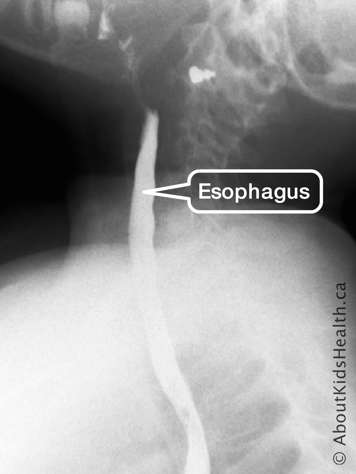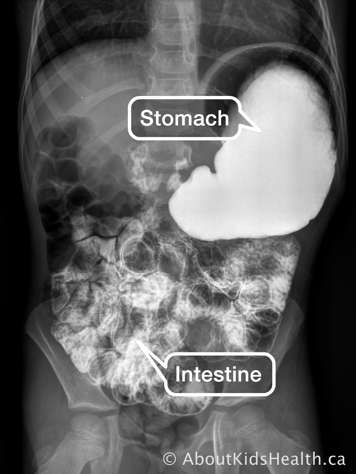What are ESD and ESSB tests?

ESD and ESSB are tests that use X-rays and a contrast medium to show doctors what is going on in your child's digestive system. A contrast medium is a liquid your child will drink. It helps the digestive system show up in X-ray pictures.
- ESD is short for esophagus, stomach and duodenum. These are the first three parts of your body's digestive system. When you eat, food goes from your esophagus to your stomach, then out of the stomach to your duodenum. An ESD test shows the doctor how these three body parts work as your child eats and drinks.
- ESSB is short for esophagus, stomach, and small bowel. The small bowel (intestine) is the longest part of your body's digestive system. The duodenum is the first section of the small bowel, and there are two other sections called the jejunum and the ileum. This test is the same as an ESD, except that it shows doctors what is going on further along your child's digestive system.
ESD and ESSB tests are usually done in a hospital
In the hospital, the tests are usually done in the Department of Diagnostic Imaging, Gastrointestinal and Genitourinary (GI/GU) area.
- The ESD test usually takes about 30 minutes. However, you can expect to be in the department for about 45 to 60 minutes to allow time for the X-ray images to be prepared, processed and checked by a radiologist.
- The ESSB test can take between three to six hours. This depends on your child's digestive system.
Your child needs to stop eating and drinking before the test
Children two years of age and younger should have nothing to eat or drink for four hours before the test.
Children over two years of age should have nothing to eat or drink from midnight the night before the test.
Explaining the test to your child
Take time to read this information carefully. Describe the test in words you know your child will understand. Use the words your family uses to describe how your body works. Children who know what to expect are usually less anxious. The test is easier and faster when your child is fully co-operative.
Young children may want to bring something comfortable to hold during the test. Your child may want to bring a stuffed toy or a blanket from home.
One parent can be with the child at all times during the test. If you are pregnant, you must leave the room when your child has the X-ray.
Three people will be involved in the test
A doctor, an X-ray technologist and a nurse will all help conduct the test, care for your child, and let you know what is happening during the test.
- The doctor is a radiologist, who specializes in carrying out X-ray procedures and interpreting (reading) the results.
- The X-ray technologist will help the doctor operate the equipment.
- The nurse will help your child throughout the test.
During the test

After checking into the GI/GU area of the Department of Diagnostic Imaging, your child will need to change into a hospital gown, using the change rooms provided. The X-ray technologist or nurse will then greet you in the waiting room and ask you to come into the X-ray room. Usually, one parent can go into the X-ray room with the child.
In the X-ray room
The room contains an X-ray table, a large camera that takes the X-ray pictures, and a television monitor. Your child will lie down on the table underneath the television camera.
Your child will be given a "barium shake" to drink. Barium is thick white liquid that will coat the inside of the esophagus, stomach, and duodenum. This coating gives a contrast so that these parts of the digestive system can be seen on X-rays. This is why the drink is called a contrast medium. The shake may be flavoured and your child may get to choose between several flavours. Some children may have trouble drinking the barium shake because it does not taste good to them, it may be hard to drink while lying down or both.
While your child is drinking, the doctor will be using the television camera to watch the barium. X-ray pictures will also be taken during and after drinking.
Although the camera makes beeping noises as the X-rays are taken, it does not touch your child. The X-rays do not hurt.
During the test, the doctor will place your child in different positions to get the best look at what is happening to the barium as your child drinks. Once your child has finished the drink and the doctor has finished taking the X-rays, the technologist or nurse will help your child off the table.
After the test
ESSB
You and your child will be sent to the waiting area. More X-rays will be taken about every 30 minutes, until the barium can be seen at the end of the small bowel.
ESD
The technologist or nurse will direct you to the change room and waiting area. You can have your child change into their clothes. You will then need to wait until the X-rays have been processed and checked by the doctor.
The receptionist or technologist will let you know when you can leave.
Outpatients may go to other appointments in the hospital or return home. The radiologist will review the ESD/ESSB study results and a report will be sent to your doctor. Your doctor will discuss the results with you at a follow-up appointment.
After-effects from the test
Because of the barium drink, your child's stools (poo) may look a little white the next few times they go to the bathroom. This is normal. Drinking lots of water for the next day or so will help your child pass the barium more easily.
At SickKids
Outpatients must first register at Diagnostic Imaging on the 2nd floor of The Elm Street Wing. You will then be directed to the GI/GU Patient Check-in desk.
If you need to cancel your child's ESD/ESSB test, please call 416-813-6068 as soon as possible. We need to give your child's appointment to another child on our waiting list. There is a long waiting list for these tests. If you are late, your child's appointment may be delayed or rescheduled.
